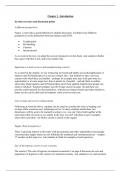Chapter 1 - Introduction
In-class exercises and discussion points
4 different perspectives
Figure 1.2 provides a good platform for student discussion. It outlines four different
perspectives on the distinction between logistics and SCM:
• Traditionalist
• Re-labelling
• Unionist
• Intersectionist
As we note in the text, we adopt the unionist perspective in this book. Ask students whether
they agree with this or not, and if not explain why.
Importance in both services and manufacturing contexts
As is noted in the chapter, we are witnessing increased and highly successful application of
logistics and SCM principles in a services context also. Ask students to take a services
context with which they are familiar – perhaps for example they may work part-time in a
supermarket or at some stage have been a patient in a hospital – and ask them to outline
where they think logistics and SCM principles can be best applied. Indeed most people can
relate to medical / hospital examples (see the Triage caselet on page 14) and these can
provide useful material for discussing how, with process improvements and other initiatives,
better service can be delivered in hospitals, often at lower total cost.
Cost savings and service enhancements
Following on from the above, students can be asked to consider the issue of making cost
savings while simultaneously enhancing service. In many students minds these two
dimensions will be seen to be mutually exclusive (i.e. you can’t have both together at the
same time). But of course as we outline in the text, you can! Ask them to give examples
where this is possible - the IKEA caselet is useful in this regard.
Supply chain transparency
There is growing interest in this topic with governments and other stakeholders increasingly
concerned that supply chains are not infiltrated by unethical and criminal practices – chapter
17 touches on this topic too. Ask students to think of examples of such practices.
Size of the logistics sector in your economy
The caselet (‘The role of logistics in national economies’) on page 8 discusses the size and
importance of logistics in the context of a national economy. Ask students to try and ascertain
,what the size of the logistics sector is in their country (it is usually the case that various
industry bodies will collate such information and which should be easily found on the web).
The ‘innovation race’, spurred on by developments at Walmart etc as outlined in the caselet,
could prompt a useful further discussion around the role of logistics and SCM developments
at individual large companies in a national economy context (this area may be more suited to
more advanced students only given the nuances and data interpretation issues involved).
Answers to end of Chapter Questions
• Are logistics and SCM only of interest to manufacturers?
Clearly the answer to this is no! Expect students to outline service-based examples (hospitals,
shops, etc) in their answers.
• Explain the key developments behind the evolution of logistics and SCM.
These are the six developments as outlined in the chapter:
- reduced transport intensity of freight
- falling product prices
- deregulation of transport
- productivity improvements
- emphasis on inventory reduction
- changes in company structure
• How do logistics and supply chain management differ?
This question is perhaps not as straightforward as it first appears. We find that students
typically think that just by defining both terms they have answered the question! However
one should demand more in a good answer to this question. It should lead into a discussion
around the four different perspectives (p12), with the student stating which particular
perspective they concur with. As noted already, we adopt the unionist perspective (i.e. that
logistics is part of the wider entity that is SCM). We also highlight on page 12 ‘…. SCM is a
wider, intercompany, boundary-spanning concept, than is the case with logistics’.
• How can best practice logistics and SCM lead to both cost reduction and service
enhancement?
Ideally students should cite cases (such as the Ikea case or the Dell case which comes at the
end of Part 1 of the book) and / or other examples with which they are familiar to highlight
their answer. In brief summary what we are stating is that smarter management of inventory
and other resources can lower end to end supply chain costs, while adopting a supply chain
view can also lead companies to do things differently and hopefully better.
• What are the benefits of deregulation of transport markets? Why does such deregulation
sometimes not work out quite as planned?
If time permits, the subject of transport deregulation, although not the focus of our book, is
worth exploring further in class.
,As we note on page 5 ‘The essence of effective deregulation is that by removing unnecessary
barriers to competition, markets become more contestable and (in theory at least) prices
should come down and service should improve’. These then are the benefits of deregulation.
Informed students should be able to cite examples to augment their answer, for example the
revolution in air travel in Europe with the emergence of the so-called ‘low-cost airlines’
following on from deregulation of the air transport sector in Europe.
With regard to the second part of the question, as we note in the book (page 5) ‘We say ‘in
theory’ because the reality in some deregulated markets has been somewhat different (with
private monopolies sometimes replacing public ones) but, in general and over the long-run,
deregulation has had a positive impact on many transport markets, leading to the provision of
both more and cheaper services’. In essence what we are saying here is that markets, left to
their own devices, can sometimes act and lead to outcomes which are not always in the best
interests of the customer. Hopefully though in the long-run, and sometimes with necessary
regulatory interventions, markets adapt in the best interests of both users and the vested
business interests.
Extra essay style question
• Discuss the various flows in a typical supply chain.
There are 3 such flows (page 10):
- Physical flows of materials
- Flows of data and information that inform the supply chain
- Resources (especially finance, but also others such as people and equipment) which
help the supply chain to operate effectively. Furthermore, not all resources in the
supply chain are tangible, for example good quality inter-company relationships are
often cited as a highly important ingredient of effective supply chains.
The key point here is that students recognise that supply chains encompass not just materials
flows, but these other flows as well. While they can write about (both forward and reverse)
materials flows, they should also discuss these other flows as well.
More questions
• What is meant by the transport cost sensitivity of freight?
• What are the various flows in a typical supply chain?
• Distinguish the upstream versus downstream parts of a supply chain.
• What is meant by the term ‘material substitution’
• Distinguish the terms ‘cargo’ and ‘freight’
• Distinguish the different container dimensions.
, Chapter 2 – Globalisation & International Trade
In-class exercises and discussion points
Globalisation
This is a topic which always sparks lively debate, although be careful matters don’t get out of
hand! Pages 23 onwards outline the various arguments as to whether globalisation is a force
for good or not. Regardless of the position adopted, to conclude the debate students might be
reminded to make the link between globalisation and logistics.
Global Reach and Sources
Sourcemap (www.sourcemap.com and http://open.sourcemap.com/) illustrates many
interesting examples of extended, stretched global supply chains, and these are usually
interesting to peruse during class.
Answers to end of Chapter Questions
Explain the linkages between economic growth, trade and shipping. How can they be
decoupled and why might this occur?
The trend lines and linkages can be clearly seen in Figure 2.1. A key point to note is that
shipping is of course a derived demand. Decoupling is also discussed in later chapters (6 and
16) with a key driver being the need to reduce the negative environmental impact associated
with increased transport demand. This can be achieved by for example making transport more
efficient and by lowering the freight transport intensity of economies. As well as
endeavouring to decouple growth in transport demand from growth in GDP, there is also
evidence of decoupling growth in merchandise trade from growth in GDP (Figure 2.2) as a
result of a number of factors including value chain shifts and a growth in services.
Identify examples of companies / products who attempt to think global and act local
(‘glocalisation’).
This corresponds to geocentricity, also discussed in the next question below. The topic is
explained on p25 of the book
Differentiate ethnocentricity, polycentricty and geocentricity, and give examples of
companies from your own country who you believe fit into each category.
These terms are clearly defined on p25. Obviously the choice of companies will depend on
the country chosen – for example if the student’s home country is Canada then an
ethnocentric company, from that perspective, could be for example a company such as Air
Canada; a polycentric company could be a company such as General Electric (although GE is
active in various sectors across a number of countries, it is still often regarded as ultimately
an American company), and a geocentric company could be a company such as SAP (given
the worldwide proliferation of SAP’s ERP systems it is difficult to associate the company
with one country of origin (it is in fact still headquartered in Germany where it was founded
in the early 1970s)).





